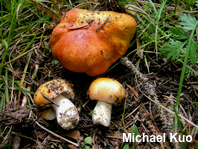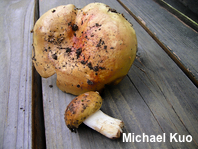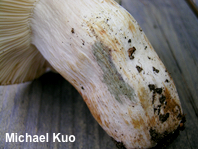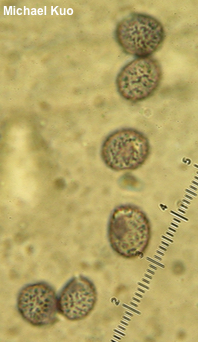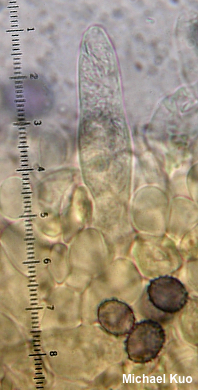| Major Groups > Gilled Mushrooms > Pale-Spored > Russula > Shrimp Russulas > Russula species 03 |

|
[ Basidiomycota > Russulales > Russulaceae > Russula . . . ] Russula species 03 by Michael Kuo, 30 September 2025 This shrimp russula from high elevation spruce-fir forests in the southern Rocky Mountains may represent an undescribed species—or it may be merely a color variant of Russula olympiana. Like other shrimp russulas, this one stains brown on handling, has a shrimp-like odor, and features a stem that turns green with iron salts. It is distinct, however, in its consistently orange cap color. At high elevation colors can be hard to determine with certainty, since bright sunlight can quickly affect pigments; I have seen pale pink to virtually white specimens of Amanita muscaria flavivolvata in perfectly fresh condition growing in grassy areas near treeline, for example. But Russula species 03 keeps its bright orange color fairly well, and neither buttons nor duff-covered specimens I have found featured red caps (a potential sign that the orange color represents faded red). Russula katarinae is also orange, but is associated with eastern white pine in the Midwest and eastern North America. Description: Ecology: Mycorrhizal with conifers (collected under Engelmann spruce, blue spruce, and subalpine fir) at high elevation; growing gregariously; July and August; distribution uncertain. The illustrated and described collections are from San Juan and Gunnison counties, in Colorado. Cap: 5–9 cm; convex becoming planoconvex; bald; dry; orange to brownish orange, sometimes mottled with reddish and yellowish shades; the cuticle peeling easily halfway or more from the margin to the center; the margin not lined. Gills: Broadly attached to the stem; close or nearly distant; short-gills present; creamy becoming pale yellow; bruising and discoloring brown. Stem: 4–7 cm long; 2–3.5 cm thick; equal; dry; bald but somewhat roughened in places; white, flushed with pink, bruising brown on handling when fresh. Flesh: White; not staining when sliced. Odor and Taste: Odor strong, shrimp-like, and slightly foul; taste not distinctive. Chemical Reactions: KOH on cap surface negative to yellowish. Iron salts on stem surface green, sometimes with a preceding pink stage. Spore Print: Yellow. Microscopic Features: Spores 7–12 x 6–10 µm including ornamentation; ellipsoid to broadly ellipsoid; ornamentation as mostly isolated amyloid warts 0.5–1.0 µm high, with a few connecting lines that rarely form zebroid patterns. Basidia 42–48 x 10–14 µm; clavate; 4-sterigmate. Pleurocystidia 50–80 x 9–12 µm; fusiform; smooth; thin-walled; with granular contents; hyaline in KOH. Cheilocystidia similar to pleurocystidia. Pileipellis an ixocutis of elements 2–6 µm wide, smooth, hyaline to dull golden in KOH; pileocystidia not found. REFERENCES: Herb. Kuo 07270602, 08180702. This site contains no information about the edibility or toxicity of mushrooms. |
© MushroomExpert.Com |
|
Cite this page as: Kuo, M. (2025, September). Russula species 03. Retrieved from the MushroomExpert.Com Web site: http://www.mushroomexpert.com/russula_species_03.html |
